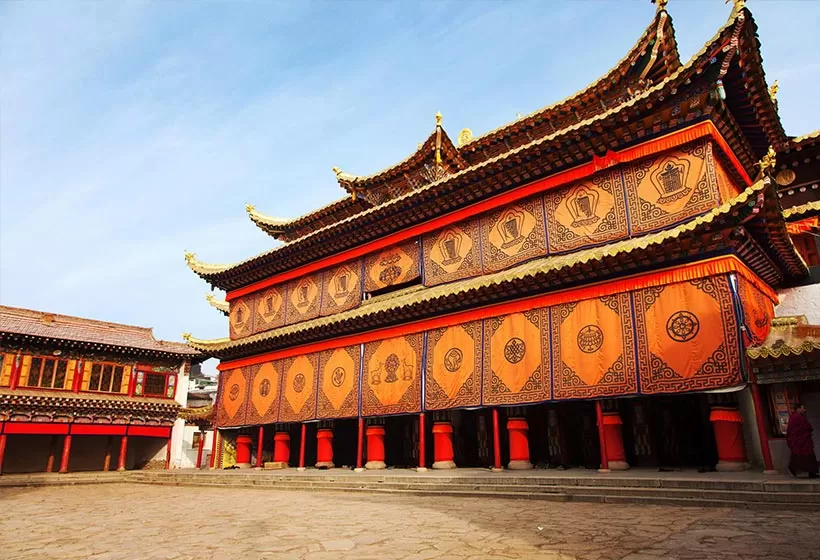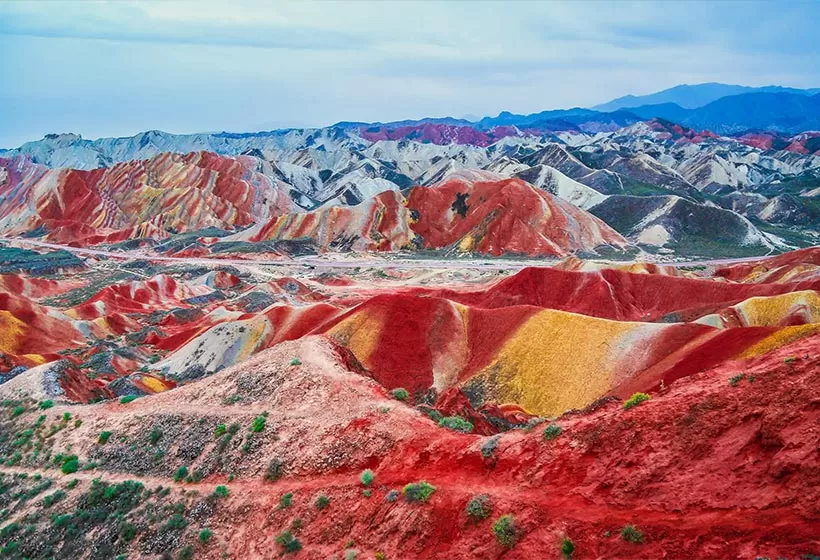Top 10 Famous Tourist Gansu Attractions and Sightseeing
Gansu boasts a history spanning over 8,000 years, and one of the important birthplaces of the Chinese nation and Huaxia civilization. This region is rich in the cultural heritage of the ancient Silk Road, adorned with the vibrant colors of the Danxia landform, and showcases the magnificent bends of the Yellow River, along with the stunning gems of the "Jiangnan of the Frontier". Following are the Gansu top 10 attractions
Top 1: Dunhuang Mogao Caves
The Mogao Caves, located at the western end of the Hexi Corridor in Dunhuang. They carved from the Sixteen Kingdoms period to the Yuan Dynasty, spanning approximately 1,000 years, which is unparalleled among Chinese cave complexes. These caves serve as a brilliant artistic repository and an important testament to the dialogue and exchange between different civilizations along the ancient Silk Road.
Currently, the Mogao Caves feature 735 caves, preserved over 45,000 square meters of murals and more than 2,400 clay sculptures, along with five wooden eaves from the Tang and Song Dynasties, which reflect the evolution of stone grotto art and hold a prestigious historical position within this art form. The painted and sculpted Buddhist figures and Buddhist scriptures within the caves are places for practitioners to worship and meditate. Because the rock in the Mogao Grottoes is loose and not suitable for stone carving, the statues are mainly made of clay murals. The Buddhist figures and wall paintings in the cave integrate these two art forms into a cohesive whole. The craftsmanship of the clay sculptures is exquisite and rich in imaginative detail, while the murals feature grand and diverse compositions, vibrant colors, and intricate, flowing lines.
Dunhuang cave art is a multidimensional art form that integrates architecture, sculpture, and painting. Built upon the excellent traditions of the Han culture and those of the neighboring Western regions, ancient artists incorporate foreign techniques, creating Buddhist artworks that feature the local characteristics of Dunhuang and folk customs of Chinese nationality
- Address: No. 217 Provincial Road, Dunhuang City, Gansu
- Open Hours: 08:00 AM – 06:00 PM
- Tour Length: 1 day
Top 2: Jiayu Pass
Jiayu Pass, known as the "First and Greatest Pass under Heaven", is located in the narrowest part of a valley 5 kilometers west of Jiayuguan City. The walls on both sides traverse the desert and Gobi, that is the westernmost point of the Ming Great Wall. Referred to as the throat of Hexi, it gained the title of the "Key to the Frontier" due to the strategic location and the majestic architecture. Jiayu Pass served as a vital transportation hub along the ancient Silk Road and is one of the three great wonders of the Great Wall of China.
Construction of Jiayu Pass began in 1372, stretching approximately 60 kilometers and standing at the western terminus of the Great Wall. Situated at the foot of the Jiayu Mountain, it stands tall and majestic, with steep cliffs and a breathtaking presence. Within Jiayu Pass, watchtowers and fortifications are scattered, forming a layered defense system of inner wall, outer wall and moat. The gate tower is square, with two entrances on the east and west, and each corner features a watchtower, with more extra watchtower along the north and south walls, formidable and solid.
- Address: Guancheng South Road, Yuquan Town, Jiayuguan City, Gansu
- Open Hours: 08:30 AM – 06:00 PM
- Tour Length: 1-2 hours
Top 3: Zhangye Danxia
Zhangye Danxia landform, located in the middle of the Hexi Corridor in Gansu Province, formed approximately 2 million years ago and spans an area of over 510 square kilometers, making it the second largest after China's Chishui Danxia. It is one of the most well-developed and diverse Danxia in terms of landform shapes in China, with its colorful hills being the most vibrant and extensive in the country.
Zhangye Danxia is primarily composed of red gravel, sandstone, and mudstone, distributed along both sides of the Liyuan River and its tributaries. It is divided into two major groups, north and south, separated by the Zhangye Oasis Basin. The northern group is relatively flat, characterized by monocline ridges with clear mountain textures and patterns, while the southern group is famous for its intricate strata, steep cliffs, vertical joints, and vibrant colors. Thousands of cliffs and mountain peaks display vivid shades of crimson and reddish-brown, setting off each other and showcasing its own beauty. The unique formations and bright hues make the Qilian Mountains appear as if they are carved with striking peaks and vibrant, multicolored ridges.
- Address: North foot of Qilian Mountain, Zhangye City, Gansu
- Open Hours: 07:00 AM – 07:00 PM
- Tour Length: 2-4 hours
Top 4: Mingsha Mountain & Crescent Spring
Mingsha Mountain (Singing Sand Dunes) stretches 40 kilometers east to west and about 20 kilometers north to south, with its highest peak reaching 1,715 meters, made up of fine sand in red, yellow, green, black, and white colors. As the westerly and northerly winds carrying much sand encounter the mountain, the sand particles are deposited, and over time, Mingsha Mountain took shape. For thousands of years, Mingsha Mountain has stood tall, and the sound of the sand remains as vibrant as ever. Viewed from above, the mountain’s winding ridges and layered contours create a wave-like appearance, with alternating light and shadow forming a striking contrast. From below, the towering dunes resemble the majestic pyramids of ancient Egypt, shimmering in the sunlight.
Crescent Spring, nestled within Mingsha Mountain, is a crescent-shaped body of water, deep in the east and shallow in the west, and the deepest point is about 5 meters. The spring was formed due to a combination of loose geological structures, low-lying terrain, and relatively high regional groundwater levels. The harmonious coexistence of sand and water, mountain and spring, makes it the unique natural wonder of "The First Spring in the Desert".
- Address: Mingshan Road, Dunhuang City, Jiuquan City, Gansu
- Open Hours: 06:00 AM – 07:30 PM
- Tour Length: 4-6 hours
Top 5: Maiji Mountain Grottoes
Maiji Mountain Grottoes, located in Maiji District, Tianshui City, are the central attraction of the Maiji Mountain Scenic Area. The grottoes is one of China's Four Great Grottoes, sitting on an isolated peak on the northern side of the western end of the Qinling Mountains, with the mountain rising 142 meters high.
The Maiji Mountain Grottoes were first constructed during the Later Qin period of the Sixteen Kingdoms, with over 1,600 years of continuous excavation and restoration. Currently, 221 caves, 3,938 sculptures with a total of 10,632 figures, and 979.54 square meters of murals have been preserved. The figures preserved in the grottoes are mostly mud sculptures, which reflect the sculpture styles of various historical periods, earning the title "Eastern Sculpture Gallery".
The statues range in size, with the tallest exceeding 10 meters and the smallest barely over 10 centimeters. These sculptures have both form and spirit, and strong high aesthetic value. The robust and imposing seated Buddha in Cave 78, the compassionate and serene seated Buddha in Cave 44, the smiling disciple in niche 9 of Cave 133, and the whispering Bodhisattva and disciple in Cave 121, vividly demonstrating the rich regional characteristics of the Maiji Mountain sculptures.
- Address: Maiji Mountain Scenic Spot, Maiji Town, Maiji District, Tianshui City, Gansu
- Open Hours: 08:00 AM – 04:30 PM
- Tour Length: 2-3 hours
Top 6: Kongtong Mountain
Kongtong Mountain, located 15 kilometers west of Pingliang City, is renowned as the "First Taoist Mountain in China." It serves as a strategic point on the Silk Road, nestled between the Liupan Mountains and the Qin Plateau, with the Jing River and Yanzhi Rivers encircling it. Favored by emperors and literati throughout history, Kongtong Mountain is not only a natural beauty spot but also a significant carrier of Taoist culture and history.
With an elevation ranging from 1,456 to 2,123.5 meters and a vertical rise of 667.5 meters, the main peak of Kongtong Mountain reaches 2,123 meters. The forest coverage exceeds 95%, covering an area of 83.6 square kilometers. The majestic cliffs seem to touch the sky, exuding an indomitable spirit as a masterpiece of nature. The dense forests put on a layer of mystery, like a mist-shrouded fairyland that brings peace and tranquility and escapes from hubhub. The high gorges and calm lakes are even the finishing touch, with reflections shimmering on the water, both with the softness of the Li River and without losing the grandeur of northern landscapes.
- Address: Kongtong Ancient Town, Kongtong District, Pingliang City, Gansu
- Open Hours: 07:30 AM – 07:00 PM
- Tour Length: 3-6 hours
Top 7: Labrang Monastery
Labrang Monastery, one of the six major monasteries of the Gelug sect of Tibetan Buddhism, is globally renowned as the "World Academy of Tibetan Studies". It preserves the best Tibetan Buddhist educational system in China. At its peak, the monastery housed over 4,000 monks.
The monastery faces south and covers an area of 866,000 square meters, with a built area of more than 400,000 square meters. It comprises over 90 main buildings, including six major academies, 16 Buddha halls, lecture platforms, pagodas, and more, forming a magnificent architectural complex with Tibetan characteristics, with rooms over 10,000.
All the monastery’s buildings are constructed primarily from local stone, wood, soil, and tamarisk, with minimal use of metal. The architecture is wider at the base and narrower at the top, resembling a trapezoid, with stone exteriors and wooden interiors. Large and medium-sized structures are adorned with golden wheels, treasure vases, banners, and copper lions. Some halls also incorporate elements of traditional Han architecture, with palace-style roofs covered in gilded copper or green glazed tiles.
The monastery holds over 10,000 pieces of ethnic artifacts and Buddhist art and preserves the personal belongings of successive Jamyang Zhepa incarnations and imperial decrees, seals, and gifts from Chinese emperors.
More about the Labrang Monastery »
- Address: No. 252, Renmin West Street, Labrang Town, Xiahe County, Gannan Tibetan Autonomous Prefecture, Gansu
- Open Hours: 08:00 AM – 06:00 PM
- Tour Length: 2-3 hours
Top 8: Zhagana
Zhagana is a natural stone city, which means a “stone box” in Tibetan, located in Gannan Tibetan Autonomous Prefecture, about 30 kilometers northwest of Diebu County. The terrain resembles both a grand palace and a natural rock fortress. The steep mountains and misty clouds give it an ethereal, otherworldly feel. The local Tibetan villages blend pastoral, farming, hunting, and woodcutting activities, making it a model of coexistence between human life and nature.
To the north of Zhagana stands the majestic and awe-inspiring Guanggai Mountain, also known as "Stone Mirror Mountain” because its gray-white rocks easily reflect sunlight. To the east, towering cliffs rise into the clouds, surrounded by mist. In the south, two stone peaks stand side by side, forming a natural stone gate. Further south around Dongwa and Najia areas, steep cliffs tower and clear streams rush, with water mills spinning continuously. The rugged landscape and stunning scenery resemble an immense stone palace, hailed as the birthplace of Adam and Eve nearly a century ago.
- Address: X412 Dibu County, Gannan Tibetan Autonomous Prefecture, Gansu
- Open Hours: 00:00 AM – 12:00 PM
- Tour Length: 2-3 hours
Top 9: White Pagoda Mountain Park
White Pagoda Mountain Park, located in the northern part of Chengguan District, Lanzhou City, Gansu Province, is named after the White Pagoda Temple situated at its summit. The combination of the pagoda and the Lanzhou Yellow River Iron Bridge creates a majestic scene, making it one of the symbols of Lanzhou.
The terrain of White Pagoda Mountain is rises and falls, coiling with suburbs. The White Pagoda Temple, originally built in the Yuan Dynasty and reconstructed in the Ming Dynasty, has a rectangular layout. The White Pagoda itself, standing at about 17 meters tall with seven tiers and eight sides, is topped with a green spire and rests on a round base, with whole white body giving it straight and elegant. The pagoda embodies intricate architectural design and exquisite sculptural art, reflecting the ingenuity and artistic creativity of ancient laborers, marking it as a masterpiece of ancient Chinese architecture. From the summit of White Pagoda Mountain, visitors can enjoy a panoramic view of Lanzhou's cityscape.
- Address: No.1 North Binhe Middle Road, Chengguan District, Lanzhou City, Gansu
- Open Hours: 06:30 AM – 07:30 PM
- Tour Length: 2-3 hours
Top 10: Yellow River Iron Bridge
Lanzhou Yellow River Iron Bridge, known as the "First Bridge over the Yellow River," was designed by an American company, constructed by both German Telge & Schroeter and Chinese craftsmen. In 1928 in order to commemorate Sun Yat-sen, it also gained the name of "Zhongshan Bridge". Spanning 233.5 meters and 8.36 meters wide, it is the first bridge in northwestern China built with foreign technology, making it a key to studying modern history and giving it a unique position in China's architectural history.
At night, the Yellow River Iron Bridge glows magnificently, resembling a golden dragon resting over the river. The dazzling bridge, the tranquil Yellow River, and the misty mountains are integrated and familiar with the city over centuries of history, permeating the atmosphere of culture and modern city.
- Address: The middle section of Binhe Road under Baita Mountain, Lanzhou city, Gansu
- Open Hours: 00:00 AM – 12:00 PM
- Tour Length: 1 hour
Customize Your Unique Gansu Silk Road Trip

If you are interested in one of the Gansu itineraries mentioned above, please contact us, and we will be happy to customize it and provide a quote tailored to your preferences.
Alternatively, if you would like to customize your Gansu Tour, please visit our Gansu Tour Customized Center. We assure you that you will receive a reply within 24 working hours.
Informative Articles for Your Gansu Trip
 the Silk Road
the Silk Road- Travel Guide: attractions, weather, hotels, food, etc.
- Top destinations: best places to visit in Gansu
- Travel itineraries: itineraries for your reference
- Local culture: brief history, folk culture, festivals, etc.
- Weather: the best time and seasons to visit Gansu
- Top attractions: sightseeings to watch in Gansu
- Cultural immersions: activities to spotlight your trip
- Unique perspective: best interesting things to do
- Local food: what to eat while traveling in Gansu
- Luxury hotels: best accommodation to stay in Gansu
- Dunhuang Tours: customized Gansu tours for your reference
GREAT FAMILY CHINA TOUR
JULY 2024 We wanted to thank Grace at China Culture tour for organizing a great tour of China. We enjoyed our Beijing - Xian-Chengdu -Guilin -Yangshuo - Shanghai trip. Our local guides Bruce in Beijing, Susan in Xian, Jane in Chengdu, Mike in Guilin and Mary in Shanghai took care of us…read more details »
Teng Han L from SINGAPORE
Ready to Create a Unique Dream Travel?


